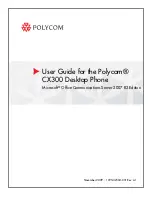
HUAWEI TE80 Videoconferencing Endpoint
Administrator Guide
10 Maintenance
Issue 02 (2014-03-30)
Huawei Proprietary and Confidential
Copyright © Huawei Technologies Co., Ltd.
113
Call status: includes the line rate, video resolution, video rate (frame rate), presentation
resolution, presentation rate (frame rate), audio rate, video packet loss rate, presentation
packet loss rate, audio packet loss rate, conference participating duration, and
presentation token. This information is displayed only after the endpoint joins a
conference.
Conference parameters: includes the call bandwidth, video protocol, video bandwidth
(frame rate), audio protocol, audio bandwidth, presentation protocol, presentation
bandwidth (frame rate), remote site number, media stream encryption, conference
number for video access, conference number for audio access, ISDN trunk number,
conference number for ISDN access, and password for conference authentication. This
information is displayed only after the endpoint joins a conference.
Input port status: includes the video information of all video input and USB1 and USB2
ports as well as air content sharing information.
4 x E1 line status (applicable only to the TE80)
10.4 Querying System Information
System information helps you maintain your endpoint.
Choose
Advanced
>
Diagnostics
>
System Information
. On the displayed
System
Information
screen, you can check:
Version information
Specification information
−
Audio and video protocols and video resolutions supported by your endpoint
−
Network ports provided by your endpoint and the maximum bandwidth supported by
each port
−
Whether your endpoint supports the Session Initiation Protocol (SIP)
−
Whether your endpoint supports dual stream, namely, the video and presentation
−
Whether your endpoint supports signaling and media stream encryption
−
Whether your endpoint is interoperable with Lync
−
Whether your endpoint supports recording, Scalable Video Coding (SVC), Wi-Fi, and
public switched telephone network (PSTN)
−
Maximum presentation resolution and codec capability of your endpoint
−
Connection status to the network diagnostics client
−
ESN
−
Valid term of the license
10.5 Querying Logs
Your endpoint logs all non-query events in real time, including user activities and commands.
The logs help with device maintenance, fault identification, and auditing.
Your endpoint can store a maximum of 100,000 log records. When the memory for recording
logs is full, new logs can still be recorded. The latest log will simply replace the oldest one.
Choose
Advanced
>
Diagnostics
>
Logs
. Then select the log you want to view.















































